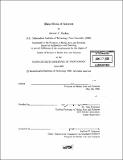Thin slices of interest
Author(s)
Madan, Anmol P. (Anmol Prem Prakash)
DownloadFull printable version (7.810Mb)
Other Contributors
Massachusetts Institute of Technology. Dept. of Architecture. Program In Media Arts and Sciences
Advisor
Alex Pentland.
Terms of use
Metadata
Show full item recordAbstract
In this thesis we describe an automatic human interest detector that uses speech, physiology, body movement, location and proximity information. The speech features, consisting of activity, stress, empathy and engagement measures are used in three large experimental evaluations; measuring interest in short conversations, attraction in speed dating, and understanding the interactions within a focus group, all within a few minutes. In the conversational interest experiment, the speech features predict about 45% of the variance in self-reported interest ratings for 20 male and female participants. Stress and activity measures play the most important role, and a simple activity-based classifier predicts low or high interest with 74% accuracy (for men). In the speed-dating study, we use the speech features measured from five minutes of conversation to predict attraction between people. The features predict 40% of the variance in outcomes for attraction, friendship and business relationships. Speech features are used in an SVM classifier that is 75%-80% accurate in predicting outcomes based on speaking style. In the context of measuring consumer interest in focus groups, the speech features help to identify a pattern of behavior where subjects changed their opinions after discussion. Finally, we propose a prototype wearable 'interest meter' and various application scenarios. We portray a world where cell phones can automatically measure interest and engagement, and share this information between families and workgroups.
Description
Thesis (S.M.)--Massachusetts Institute of Technology, School of Architecture and Planning, Program in Media Arts and Sciences, 2005. Includes bibliographical references (p. 87-92).
Date issued
2005Department
Program in Media Arts and Sciences (Massachusetts Institute of Technology)Publisher
Massachusetts Institute of Technology
Keywords
Architecture. Program In Media Arts and Sciences